METS 2016: Navico, Fusion, Airmar and Signal K
This year’s annual Marine Equipment Trade Show (METS) in Amsterdam seemed busier than ever. It’s good to see that the marine industry has largely recovered, although the sailboat business still seems to lag behind behind motorboats. The super yacht halls were very busy too. I saw some exciting new developments from Navico, who were showing the brand new NSS evo3 and B&G Zeus3 as well as their recently announced instrument displays. Fusion had a new high-end speaker, and Airmar showed me their brand new electromagnetic DX900+ multifunction speed sensor.
Simrad NSS evo3 and B&G Zeus3
 First up is the new ‘evolution’ of Navico displays in the form of Simrad NSS evo3 and B&G Zeus3. Visually they look quite similar to the previous generation; it seems that the designers are now satisfied that a combination of touch and keyboard is the way to go in the mid-range. Part of what drives these upgrades, I think, is that the low-end devices had overtaken these mid-range series with built in features. So now all the new Navico MFDs contain WiFi and have sonar built in. Another part is the continued refinement of the user interface (UI). Besides seven buttons and a rotary knob there is now a separate cursor pad. Having more controls means it is now possible to drive the complete UI without needing the touchscreen at all. If you’re on a wild ride you can even disable the touch controls, thus preventing accidental touches from messing with your display. The LCD screens have been improved, with higher resolution, better sunlight visibility and improved off-angle color reproduction.
First up is the new ‘evolution’ of Navico displays in the form of Simrad NSS evo3 and B&G Zeus3. Visually they look quite similar to the previous generation; it seems that the designers are now satisfied that a combination of touch and keyboard is the way to go in the mid-range. Part of what drives these upgrades, I think, is that the low-end devices had overtaken these mid-range series with built in features. So now all the new Navico MFDs contain WiFi and have sonar built in. Another part is the continued refinement of the user interface (UI). Besides seven buttons and a rotary knob there is now a separate cursor pad. Having more controls means it is now possible to drive the complete UI without needing the touchscreen at all. If you’re on a wild ride you can even disable the touch controls, thus preventing accidental touches from messing with your display. The LCD screens have been improved, with higher resolution, better sunlight visibility and improved off-angle color reproduction.
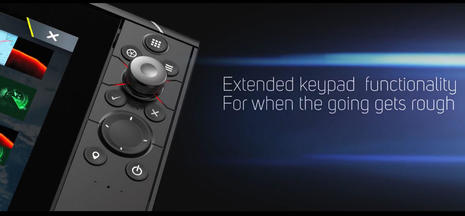 What I think is the most important development here, and a very smart move, is that Navico has included a customised web browser in their new NOS (Navico Operating System). Until now integration with parties like Mercruiser and CZone was done by including additional UI pages written by either party, but included in the software image that was installed in the MFD. This means you need tight cooperation between two development teams and a new release of the MFD software if something in the digital switching system or engine changed. By moving to a HTML5 based web browser this is now much easier. On Simrad NSS evo3 the launching integration partner for this is Naviop, who they have been working with for over a year now (as Ben reported from METS 2015). On Zeus3 they are using the HTML browser to allow full configuration of the H5000 CPU, which required a laptop or tablet until now. I’m sure that they will find new uses for the web browser.
What I think is the most important development here, and a very smart move, is that Navico has included a customised web browser in their new NOS (Navico Operating System). Until now integration with parties like Mercruiser and CZone was done by including additional UI pages written by either party, but included in the software image that was installed in the MFD. This means you need tight cooperation between two development teams and a new release of the MFD software if something in the digital switching system or engine changed. By moving to a HTML5 based web browser this is now much easier. On Simrad NSS evo3 the launching integration partner for this is Naviop, who they have been working with for over a year now (as Ben reported from METS 2015). On Zeus3 they are using the HTML browser to allow full configuration of the H5000 CPU, which required a laptop or tablet until now. I’m sure that they will find new uses for the web browser.
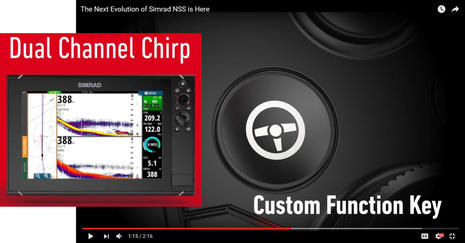 Lastly I find the new addition of PredictWind integration in NOS very useful. It allows users of the PredictWind weather service to download forecasts directly onto their plotter and view GRIB files and predictions directly over the chart window. Navico is also making it possible to download updates for the chart plotter itself directly from the device, further enhancing their GoFree strategy. I’ve seen a different part of their download update capability in action on my own Lowrance HDS2T last weekend — I switched it on and it reported that I should update the software on my AIS. Very cool.
Lastly I find the new addition of PredictWind integration in NOS very useful. It allows users of the PredictWind weather service to download forecasts directly onto their plotter and view GRIB files and predictions directly over the chart window. Navico is also making it possible to download updates for the chart plotter itself directly from the device, further enhancing their GoFree strategy. I’ve seen a different part of their download update capability in action on my own Lowrance HDS2T last weekend — I switched it on and it reported that I should update the software on my AIS. Very cool.
I hope to make a more in depth report on this in Spring, as I will likely be updating my HDS2T to Zeus3 once it is available.
Simrad IS42 and Triton2
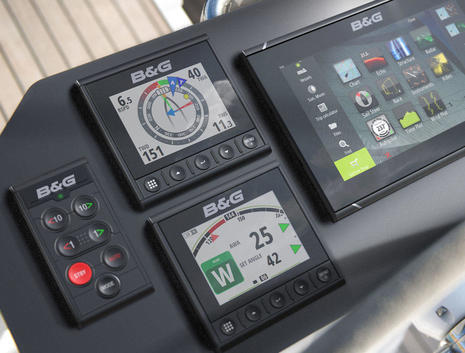 Also on show were the Simrad IS42, AP44 and B&G Triton2 displays that were covered by Ben when announced in September but I was able to see in the flesh. They have beautifully rendered screens with (if you want) very high information density. The AIS display seems a bit of a gimmick, but I really liked the updated SailSteer page that has improved markedly over the wind page in the earlier generation IS40/Triton. I also liked the rotary knob on the AP42 and the buttons in general are much nicer with a better feel, so it is much clearer when you have actually pressed a button. I also like the capability to use a reverse color palette with white letters on a dark background. There are two downsides to these new displays though. Software updates need to be applied over USB, so you need access to the backside to update them. Furthermore they are not direct drop in replacements as the rear side doesn’t use the traditional circular hole that earlier versions (and most of the competition) use. You now need to cut a 10.5 cm square cutout, which also means you only have a 6.5 mm overlap of the display over the hole.
Also on show were the Simrad IS42, AP44 and B&G Triton2 displays that were covered by Ben when announced in September but I was able to see in the flesh. They have beautifully rendered screens with (if you want) very high information density. The AIS display seems a bit of a gimmick, but I really liked the updated SailSteer page that has improved markedly over the wind page in the earlier generation IS40/Triton. I also liked the rotary knob on the AP42 and the buttons in general are much nicer with a better feel, so it is much clearer when you have actually pressed a button. I also like the capability to use a reverse color palette with white letters on a dark background. There are two downsides to these new displays though. Software updates need to be applied over USB, so you need access to the backside to update them. Furthermore they are not direct drop in replacements as the rear side doesn’t use the traditional circular hole that earlier versions (and most of the competition) use. You now need to cut a 10.5 cm square cutout, which also means you only have a 6.5 mm overlap of the display over the hole.
Fusion
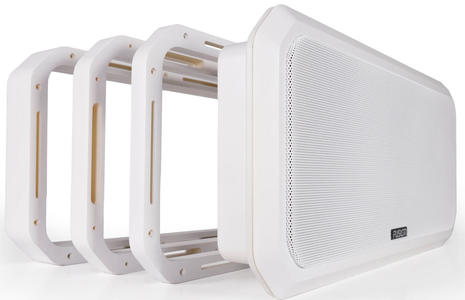 As Ben reported last month, Fusion is still on a roll as Garmin lets them do their thing quite separately from the mothership even after the takeover — they’re not taking the word Fusion literally in that particular sense! Besides what Ben got to see I was able to see the new Fusion Sound-Panel in action. It’s a dual speaker system capable of stereo sound, all encapsulated in a neat, single, very shallow enclosure. It has uncharacteristically subdued styling for Fusion, with just a small emblem and no swishes, swashes or LED lighting (which look cool on a powerboat but may be out of place on a more traditional yacht.) It’s fully closed at the back as well, ensuring well defined bass. The sound environment at the show didn’t lend itself well to a qualitative assessment, but given the size of the drivers and their reputation I’m pretty sure it will sound very nice indeed.
As Ben reported last month, Fusion is still on a roll as Garmin lets them do their thing quite separately from the mothership even after the takeover — they’re not taking the word Fusion literally in that particular sense! Besides what Ben got to see I was able to see the new Fusion Sound-Panel in action. It’s a dual speaker system capable of stereo sound, all encapsulated in a neat, single, very shallow enclosure. It has uncharacteristically subdued styling for Fusion, with just a small emblem and no swishes, swashes or LED lighting (which look cool on a powerboat but may be out of place on a more traditional yacht.) It’s fully closed at the back as well, ensuring well defined bass. The sound environment at the show didn’t lend itself well to a qualitative assessment, but given the size of the drivers and their reputation I’m pretty sure it will sound very nice indeed.
Airmar DX900+
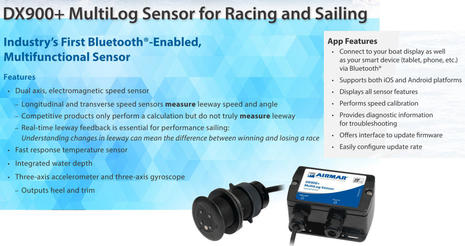 I am happy to report that Airmar is now finally shipping the long awaited ST900/950 ultrasonic speed sensor (for either NMEA0183 or NMEA 2000 output). Reading the updated Airmar brochure PDF it sounds all very well and seems especially suited to high speed motorboats. What was even more interesting though was another new paddle-less electromagnetic speed sensor oriented to racing and high-end sailboats, which will be on the market in just a few months. I wasn’t the only one impressed as the DX900+ MultiLog won the DAME electronics and software category award. Airmar was confident enough to let me speak to the three French engineers who developed it. It’s always a good sign if a company lets you talk directly to the engineers behind the product.
I am happy to report that Airmar is now finally shipping the long awaited ST900/950 ultrasonic speed sensor (for either NMEA0183 or NMEA 2000 output). Reading the updated Airmar brochure PDF it sounds all very well and seems especially suited to high speed motorboats. What was even more interesting though was another new paddle-less electromagnetic speed sensor oriented to racing and high-end sailboats, which will be on the market in just a few months. I wasn’t the only one impressed as the DX900+ MultiLog won the DAME electronics and software category award. Airmar was confident enough to let me speak to the three French engineers who developed it. It’s always a good sign if a company lets you talk directly to the engineers behind the product.
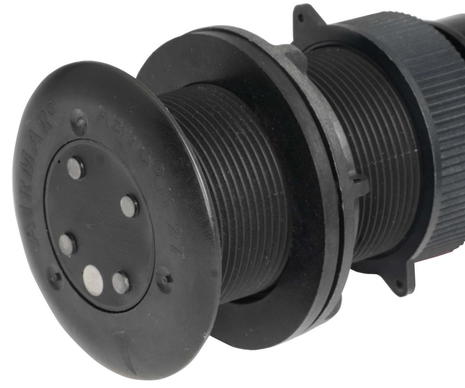 The first thing I liked is that it adapts existing technology to a new use. The core of this same sensor has been used in the fishing market for years to monitor trawls. The sensors are mounted on the net ends because the fishermen want to keep the mesh square so that the trawl has the optimal size and strength, and thus they must measure sideways as well as forward speed. The beauty for sailors is that the DX900+ can measure leeway directly, instead of inferring it from the difference between speed through water and speed over ground. As the sensor is fully symmetrical it can even measure reverse speeds accurately. It’s been tested in non-saline waters as well as sea water. It also contains a fast response temperature sensor (I think it’s the fifth metal surface you see) and a three-axis accelerometer and gyroscope, outputting heel and trim. Since the technology measures in the boundary layer it does require some calibration, but the engineers have found that one point calibration is good enough for all but high end racing conditions.
The first thing I liked is that it adapts existing technology to a new use. The core of this same sensor has been used in the fishing market for years to monitor trawls. The sensors are mounted on the net ends because the fishermen want to keep the mesh square so that the trawl has the optimal size and strength, and thus they must measure sideways as well as forward speed. The beauty for sailors is that the DX900+ can measure leeway directly, instead of inferring it from the difference between speed through water and speed over ground. As the sensor is fully symmetrical it can even measure reverse speeds accurately. It’s been tested in non-saline waters as well as sea water. It also contains a fast response temperature sensor (I think it’s the fifth metal surface you see) and a three-axis accelerometer and gyroscope, outputting heel and trim. Since the technology measures in the boundary layer it does require some calibration, but the engineers have found that one point calibration is good enough for all but high end racing conditions.
Another DX900+ advantage over a paddle wheel speed sensor is its sturdiness. The four speed measuring pins stick out of the epoxy core about 1 mm or so, to ensure a good bond of the epoxy to the alloy. Since they are bonded in completely it should survive being covered by a sling when hauling the boat (it’s also retractable), or flotsam passing by whilst sailing.
There will be three models, one with speed and temperature outputting via NMEA 0183, and two with depth, speed and temperature and either 0183 or 2000 output. The latter include a small interface box. All three are calibrated using an application from your smartphone or tablet, and the BlueTooth connection can also be used to view the data. Software updates will be possible using this method as well.
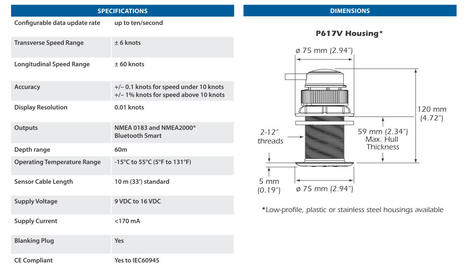 As you can imagine the DX900+ is a much more complicated product than a simple paddle wheel sensor. The predicted end user price will be around $1,400. This means it’s quite a lot more expensive than a DST800, but if you want to have direct leeway measurement, or are just fed up enough about cleaning or breaking your paddle wheel, this seems to be a very good option. And lastly it’s a simple retrofit as it fits the DST800 housing perfectly. I hope to report on a field test soon, as Airmar have promised to come by and install one on my sailboat.
As you can imagine the DX900+ is a much more complicated product than a simple paddle wheel sensor. The predicted end user price will be around $1,400. This means it’s quite a lot more expensive than a DST800, but if you want to have direct leeway measurement, or are just fed up enough about cleaning or breaking your paddle wheel, this seems to be a very good option. And lastly it’s a simple retrofit as it fits the DST800 housing perfectly. I hope to report on a field test soon, as Airmar have promised to come by and install one on my sailboat.
Signal K
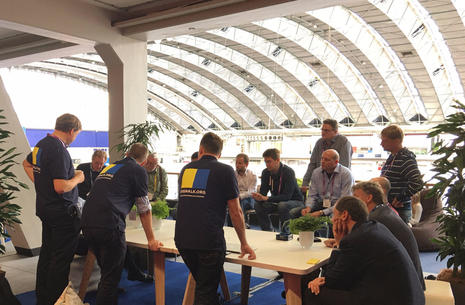 I didn’t have as much time as normal to walk around with my “Panbo hat” as there were two Signal K meetings and some meetings with vendors involved. We had a “meetup” with about 20 people meeting the four out of five Signal K core team members present. Not only was it fun to finally meet each other, but the core team was amazed that so many people took the effort to come over! Discussions continued until late at night at a local Amsterdam “brown cafe” where bonds were improved over drinks and dinner. This resulted in a commitment by the Signal K core team that we will release version 1.0 of the specification this year — likely between Christmas and the end of the year. New versions will be released after that on a regular schedule, probably every 12 months as that is a natural cycle in boating.
I didn’t have as much time as normal to walk around with my “Panbo hat” as there were two Signal K meetings and some meetings with vendors involved. We had a “meetup” with about 20 people meeting the four out of five Signal K core team members present. Not only was it fun to finally meet each other, but the core team was amazed that so many people took the effort to come over! Discussions continued until late at night at a local Amsterdam “brown cafe” where bonds were improved over drinks and dinner. This resulted in a commitment by the Signal K core team that we will release version 1.0 of the specification this year — likely between Christmas and the end of the year. New versions will be released after that on a regular schedule, probably every 12 months as that is a natural cycle in boating.
Many thanks to Kees Verruijt for again sharing some METS impressions with Panbo readers. Kees owns and operates the cool sloop Merrimac and is a member of the Signal K core team ~ editor


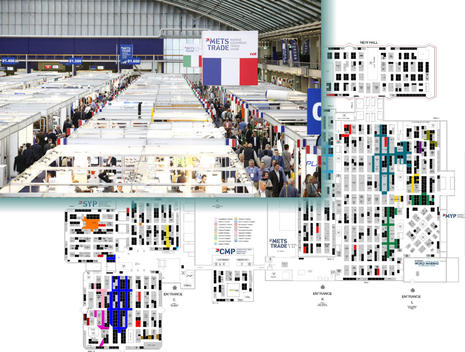
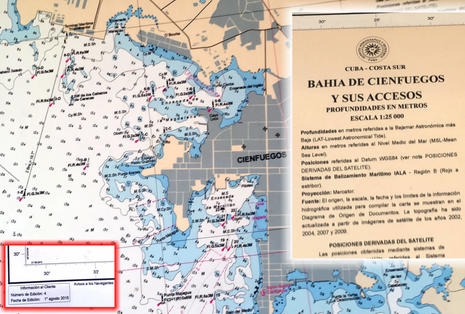
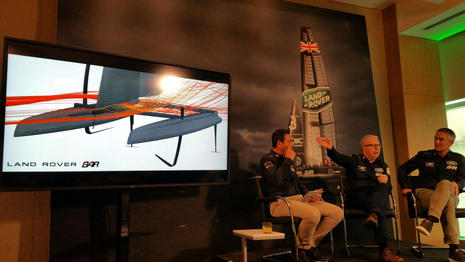
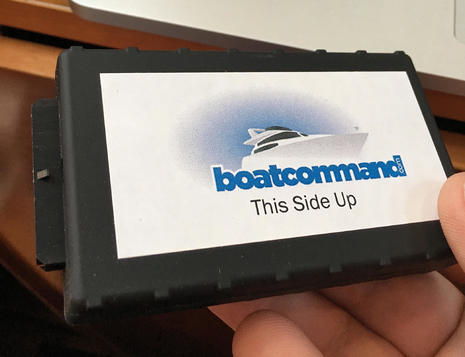
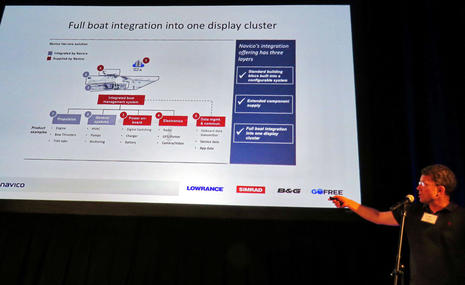








Way to go Airmar, great feature set! Kees, sounds like we can get leeway on a smartphone using Bluetooth while the sensor is connected to our boats sans leeway reporting capable MFDs?
Is leeway and or the full nmea2000 sentences of the high end sensor included in Signal K 1.0? Please see my questions for you in last Panbo entry.
Thanks Kees!
I have to write again, I am a big fan of measuring leeway, but I am also just blown away that a thru hull sensor gets bluetooth connectivity to smartphones.
All marine electronics vendors should evaluate follow Airmar’s leadership here. The ability to configure, calibrate, and update sensor software over bluetooth from a smartphone is ground breaking in marine electronic sensors, and almost(?) ground breaking in marine electronics as a whole.
Take the very latest Triton and the IS42 in this entry for example, Airmar leaves them in the dust when it comes to software updates. How much trouble would be saved by boat installers and boat owners in the future if updates were bluetooth instead of a USB port behind the instrument. (idea: maybe a future USB bluetooth dongle can plug into the Triton ?)
Then what about new features, when the MFD and instrument display manufacturers don’t keep up with sensor provides like Airmar and Maretron the boat owner is deprived of innovative features? Five years ago I installed Maretron fuel and battery monitors, and could not get the full feature set on my instrument displays years later, and maybe not even today? (For example displays show Voltage, but not remaining battery capacity in percent or minutes of time remaining)
Right off the bat, users of the new Airmar DX900+ will be able to get leeway (via bluetooth) without waiting for their boat electronics to catch up. Day 1. Yes, we would like to see it on our instrument displays and part of navigation math, but it’s quiet possible that capability won’t show up in all the major MFD brands until well after 2017. But it will be on my smartphone Day 1.
Way to go Airmar!
Kees, what should MFD and PC based vendors keep in mind when they choose to incorporate leeway into their calculation of truth about the environment around out boats? For the first time they will know if our sails are up or down, our boats are in reverse, perhaps have new information to calculate set/drift, true wind, ground wind, and I suppose some racing boats will have two of these, and there are implications for motor boats as well (better display of the cross currents in a harbor), and for those MFDs that predict set/drift will they show the variance?
Ben, was there any info from B&G as to if the Zeus3 will support ActiveCaptain with CMap charts (or maybe even any chart)? If so, how do updates work? Very curious on this as I find it highly useful in the Bahamas (broken off markers) and ICW (shoaling reports). I find the Garmin iPad app great for this, but would really like it on the waterproof display in the cockpit.
Hi Dan,
Sorry I missed your questions — I only get emails regarding comments once I write a comment on an issue myself.
There is a “Set & Drift, Rapid Update” PGN 129291 in NMEA2000, and is in Signal K 1.0 as well.
I predict my current Tritons and MFD can display this just fine.
The Racegeek guys were present at the Signal K meetup, and showed off their coming display which looks really slick. I can’t really comment on their schedule though.
I haven’t heard anything about ActiveCaptain from Navico, but that doesn’t say much as I haven’t asked.
Kees, I am confused. Leeway isn’t set & drift. Does Airmar populate PGN 129291? Do they populate it as leeway or do they calculate drift and stick it in 129291?
Leeway has been so incalculable that I didn’t even include it in my earlier Panbo post.
https://panbo.com/archives/2009/10/airmar_cs4500_part_ii_reliable_true_wind.html
Dan, you’re right. I shouldn’t answer in the middle of the night.
With the DX900+ the measured boat speed relative to the water becomes a vector in a plane with the leeway defined as the orthogonal vector to fore/aft speed, and the fore/aft vector identical to what is traditionally called boat speed.
Set+Drift is the difference between that vector and the GPS SOG+COG vector. SOG+COG and Set+Drift are both expressed as the length of the vector and a direction (in N2K.) You could argue that we should now express boat speed as a single vector length and direction as well.
I don’t have any information yet on how this is transmitted over NMEA 0183 and 2000, but will try to find out.
Just heard back, if you have a CMAP card with ActiveCaptain data the Navico plotters will display it just fine. Updates to the data come with the chart updates.
Robert, C-Map Max-N+ chart cards for Zeus2, NSS evo2, etc. have had ActiveCaptain data since last spring. I’ve seen it looking pretty good on a NSS7, but as Kees notes it is a static copy of the AC database so you won’t see new AC data until you get an updated card. More info here:
http://lightmarine.c-map.com/scdf-int/active-captain-int
But if you can wait, C-Map (which is now a sister company to Navico) just announced a new format called C-Map Insight Pro which sounds very interesting:
http://marinelink.com/news/unveils-insight-options417814
The press release doesn’t mention availability for the Bahamas but that may be included, or added separately. ActiveCaptain is definitely included, probably in a more easily updated way, and Insight Pro will also include the detailed soundings data that some Navico users like me have been collecting for years. That means serious competition for Navionics SonarCharts.
Meanwhile an interesting aspect of the new evo3 and Zeus3 displays is that they will support Navionics auto-routing and crowd-sourcing as well as C-Map’s, and apparently the new C-Map Insight format is going to available on Raymarine and Furuno displays. Behind all the intense competition there’s some cooperation going on, which sounds good for us 😉
Does Airmar have an ultrasonic speedo w/ or w/o depth and temp which fits into their DST800 thru hull, The price of the reviewed item is too spendy. I am looking for a non moving part (subject to marine fouling) speedo that I can fit in the existing thru hull hole… which will work with my present instruments… which I will be upgrading at some time in the future… The Airmar DST800 works so that is the standard for me. Any ideas?
Thanks,
Jeff
Exactly.
The IS42 and AP44 USB update option is an additional update path intended for customers not having a recent Simrad, Lowrance or B&G MFD. In a Navico system all updates, including NMEA 2000 devices, are intended to be done over Internet. I can’t see any advantage of a Bluetooth option for the update for customers with a Simrad system. The situation is of course completely different for companies like Airmar and Maretron which don’t sell complete systems.
Jeffrey, the ST900/950 may be what you’re after. I have no price information on that yet, maybe it is cheaper than the DX900+. It is speed (S) and temperature (T) only.
Hi Abbor, the IS42/AP44/Triton2 is running the same (Linux) OS as the MFD, the download is probably 50+ MByte instead of <1 MByte for the earlier IS40/IS20 devices. Like MFDs the IS42/AP44/Triton2 series cannot be updated remotely. Unlike MFDs the IS42 don’t have an ethernet connection so they cannot update themselves over the internet.
From the manual https://www.simrad-yachting.com/Root/Simrad-Documents/IS42_docs/IS42_OM_EN_988-11199-001_w.pdf page 65:
The IS42 includes a USB port of the back of the units. You use this port for software updates. You can update the software for the IS42 unit itself and for NMEA 2000 sensors connected to the network from the IS42.
Kees, I’ve been looking into this and you are right. By looking at version and platform numbers in the manual I can see the new displays are running Linux and NOS. Then WiFi, not Bluetooth would be the solution for wireless updates. I did not imagine they were using Linux for such a simple device, the advantage is of course software reuse. I Think I will stay with IS40, AP24 and AC12 which reboots in a few seconds instead of upgrading and have to wait a close to a minute when I have to power cycle NMEA 2000 to get contact with my Suzuki motor interface again.
Quit happy with AP44, IS42 and NAC2.
Yes it takes some time to start, but I don’t feel it as disturbance.
I powercycle N2K quite a lot a the moment 🙂
Does anybody know if the new Airmar 900-sonar series tolerate being covered by antifouling (year after year)? Or perhaps it can shoot right through 2 inches of barnacles?
Regarding the concern over how to update the new Navico instruments over USB without having to rip out the instrument from it’s delicate 6 mm fitting, I think the best way to go would be to leave an USB cable attached to the instrument when installing and let the other end of the cable exit the instrument housing at some discrete location.
They’re obviously about to be discontinued, but Defender has very attractive deals on remanufactured Zeus2 displays:
http://www.defender.com/activecaptain.jsp
THEY ARE STILL NOT SHIPPING as 3/21/2017 Not sure were this info came from but it is wrong. This has been in the making for years. Same answer.
Dave
With you Dave. Been waiting too long for the Dx900. Would love to give my money to someone so that I don’t have to pull the transducer out and clean the paddle wheel every time I go out. Are there any other options for getting water speed on N2K without a paddle wheel?
A short update on the DX900+, I’ve been testing one and off. At the moment I’m waiting for Airmar to ship me a new one. Whilst not ready yet (some real-life snags were hit) it is definitely coming. I guess we have to be patient. And boy is having leeway displayed directly interesting!
You can paint the plastic bits on the DX900+ but the stainless steel pins need to remain uncovered. You can paint the entire thing and then scrape the paint off the pins, with something non-metallic (wood or plastic f.i.) but after that you may need to re-calibrate.
Thanks for any news you can share Kees!
Hi Kees,
Any updates on your testing of the DX900+? Please share what you’ve learned so far. Thanks.
After about 3 years of the DX900+, I can say I wish I had just gotten the ultrasonic. The temperature has been crazy over this period, but lately has settled down, and seems correct. The Depth is the star, I can say I believe it is better than any other technology I have used. Where is shines, is in weeds, muck, or other uncertain bottoms, as it seems to shoot right through all that and give accurate readings. Best of all, it is on all the time. Which leads me to the speed. It will only report for a couple hours, sometimes the whole day, but never to the time I turn it on next. Temp and Depth are always there. What works best is if I unscrew the the Nk2 connection, then reconnect, it pops back up. But it will never follow through from one power cycle to the next. Which means I need a new transducer. Not happy with this one.